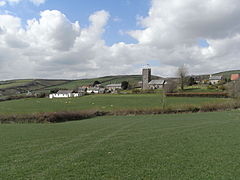Molland
| Molland | |
|---|---|
 The village of Molland viewed from the south-east |
|
| Molland shown within Devon | |
| Population | 203 (2001 Census) |
| District | |
| Shire county | |
| Region | |
| Country | England |
| Sovereign state | United Kingdom |
| Police | Devon and Cornwall |
| Fire | Devon and Somerset |
| Ambulance | South Western |
| EU Parliament | South West England |
| UK Parliament | |
Molland is small village, civil parish, dual ecclesiastical parish with Knowstone and former manor, located on the southern slopes of the foothills of Exmoor in Devon, England. It lies within the North Devon local government district.
The northern boundary of the parish rises to 1,239 feet at Round Hill on Molland Common; its southern border mostly follows the River Yeo (a tributary of the River Mole), and part of its north-eastern border defines the county boundary with Somerset. The parish is surrounded, clockwise from the east, by the Devon parishes of West Anstey, a small part of East Anstey, Knowstone, Bishop's Nympton and Twitchen. The population of the parish was 203 in 2001, down from 397 in 1901.
The village lies on minor roads about 4 miles north of the A361 road between Bampton and South Molton.
A scatter of tumuli near Round Hill on Molland Common provide the earliest evidence of humans in the parish. A pollen analysis published in 2004 suggests that during the Romano-British period Molland Common was dominated by a pastoral economy with woodland, possibly managed, restricted to the steep-sided valleys. The evidence shows that the land continued in use for pasture until the 10th century when there was a marked increase in the cultivation of cereals. The researchers concluded that this change probably indicates an increase in population, and they pointed out that the evidence is consistent with the introduction of convertible husbandry, a type of land-use management not otherwise documented until the 1500s.
The first documentary evidence for Molland appears in the Domesday Book of 1086. The Manor of Molland was a medieval manor, largely co-terminous with the existing parish of Molland. More accurately it consisted from the earliest times of two separate manors, held from separate overlords, later known as Molland-Bottreaux and Molland-Champson. Molland-Bottreaux was held from the 15th to the 18th centuries by the Courtenay family, while Molland-Champson was held by the Culme family for about 200 years until it was sold to the Courtenays in 1703. The unified manor passed to the Throckmorton family and continues in existence as a large private estate under the ownership of Clare McLaren-Throckmorton (b. 1935). In 2009 the estate comprised 6,250 acres, 1,700 of which are accounted for by Molland Moor, and includes 40 residential properties forming most of Molland village, 13 farms, the London Inn public house and additional land lettings.
...
Wikipedia

